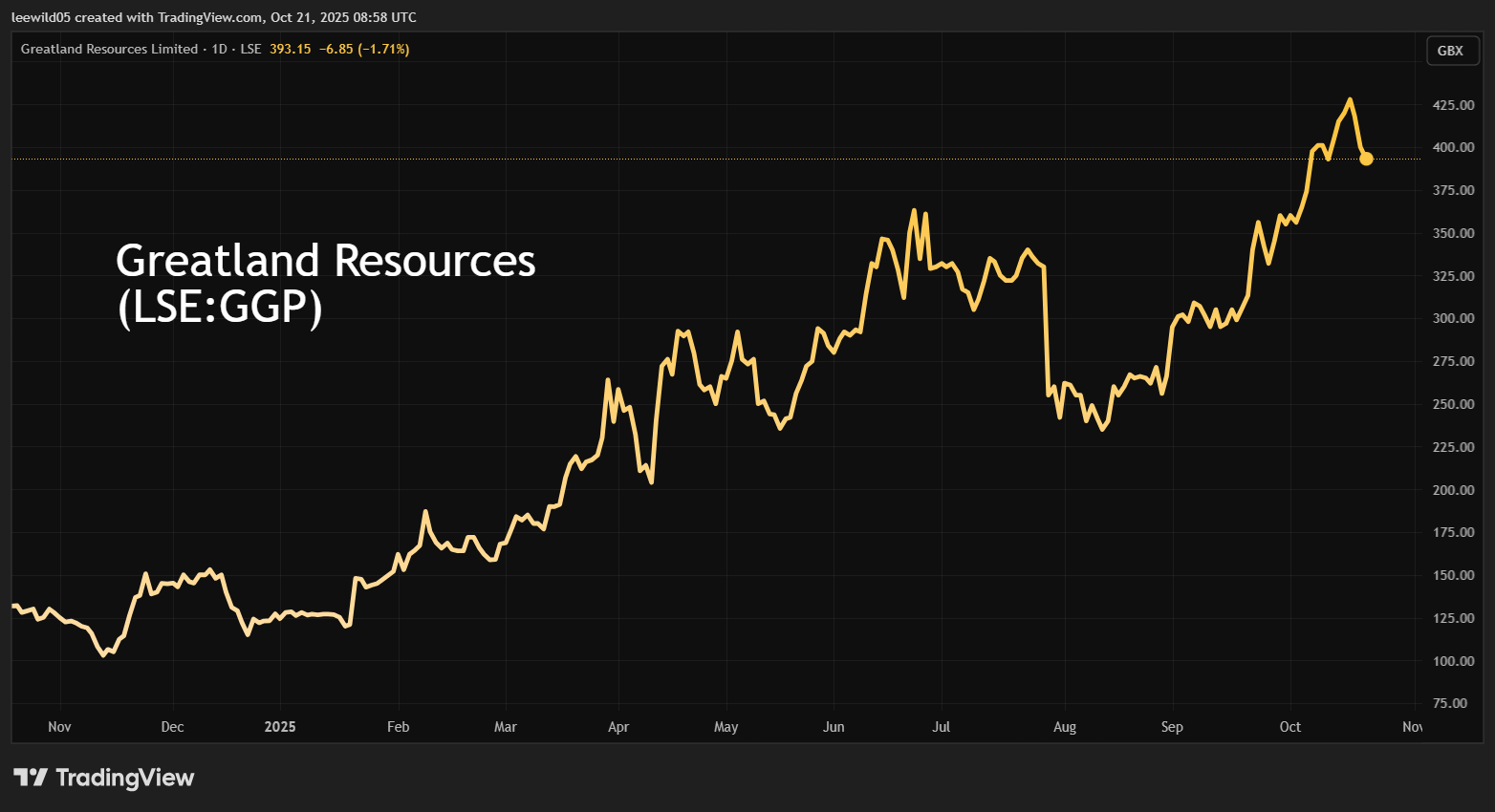Stockwatch: take profits or buckle up for more gold upside?
After an incredible year for gold, analyst Edmond Jackson reviews a successful gold mining share tip and gives a rating for the wider gold sector.
21st October 2025 11:33
by Edmond Jackson from interactive investor

In April, I drew attention to AIM-listed Greatland Gold as a “buy” at a 14.2p mid-price, or an equivalent 284p adjusting for a 20 for 1 share consolidation last June as part of a corporate restructuring to become Greatland Resources Ltd (LSE:GGP). This share is also now listed on the Australian Securities Exchange.
Call me biased with an equities background but I tend to see mining shares – despite operational risks – as a more interesting, potentially higher-rewarding play for the medium to longer term, especially if operational gearing kicks in from higher commodity prices.
- Invest with ii: SIPP Account | Stocks & Shares ISA | See all Investment Accounts
Greatland’s share price was subsequently volatile in a 250p to 350p but took off from late September to 428p (currently around 400p) as the gold price rose from as low as $3,358 an ounce in late August to within sight of $4,400 (currently around $4,319).

Source: TradingView. Past performance is not a guide to future performance.
This aspect of lag – an approximate 23% rise in the last month or so versus 30% for gold – is quite typical of resources shares where the effect on corporate earnings and asset values is not going to be known for many months, hence volatility in commodity prices could alter the financial outcome.
A more bullish interpretation, however, is the share possibly offering greater value now – or at least potential – than in April if gold prices remain elevated. This obviously is a short timeframe to confirm a bull trend; and best beware talk of a “new era” after a big rally in any asset class, recalling Irving Fisher’s remark just before the 1929 crash on how “stock prices have reached what looks like a permanently high plateau”.
Investor behaviour transforms demand for gold
The gold price trades substantially above what can be justified by fundamentals through applications such as jewellery, dentistry and electronics. Gold has historically been seen as a financial hedge against inflation and uncertainty, also the US dollar given that the two tend to trade inversely, hence it’s potentially bullish for gold right now if US interest rates are headed lower. Additionally, there is the bandwagon effect when enthusiasm for any asset becomes self-fulfilling.
Gold buying kicked off initially in 2020 amid the pandemic and subsequent rise in inflation, but was subject to profit-taking. Then, from early 2022 to 2023, central banks raised their purchases of gold partly in response to Russia’s invasion of Ukraine.
It has risen around 60% in 2025, half of this since US Federal Reserve governor Jerome Powell’s 26 August speech in which he signalled a potential shift towards interest rate cuts due to downside risks in the US labour market. Exchange-traded funds (ETFs) have accelerated buying in response, possibly also to catch up in terms of asset allocation.
- Top 10 most-purchased ETFs: September 2025
- The Analyst: cautious optimism is the popular market strategy
Gold seems part of the “everything trade”, hence is potentially vulnerable if equities sell off. I recall from stock market crashes in 1987 and 2008, how gold plummeted to much surprise.
Mind you, there’s a “momentum” feel to this trend even if it involves firmer institutions than say long/short hedge funds. Talk of gold taking over from bitcoin as an alternative asset class seems like importing the speculative mindset behind crypto currencies.
But if expectations are met, for the Fed’s 0.25% interest rate cut in September to be followed by another at its 28-29 October policy meeting, this seems likely to support gold’s trend. A dilemma is in not knowing the specifics of the US labour market while the government shutdown continues. However, September’s inflation index – another factor – will be released this Thursday.
Overall, and barring some major upset, the context looks positive for gold producers, hence it is useful to issue an update on Greatland since its annual results to 30 June were radically improved. Also, the company released an updated 10 October presentation on its website.
Strong progress but negative growth forecasts
Greatland derives revenue principally from one key project - the Telfer mine in Western Australia’s Paterson province. In fairness, there is also an adjacent brownfield Havieron gold-copper development project and significant exploration in the surrounding area.
Financial numbers to last 30 June were transformative given that they represented a first seven months ownership of Telfer, hence the first material revenues of A$961.3 million (£465.6 million) and a net profit of £214 million, making normalised earnings per share (EPS) of 32p, hence a trailing price/earnings (PE) ratio of 12.5x at the current share price of around 400p.
Despite strong operating cash flow equivalent to 54.7p per share, with only moderate capital expenditure of 15.3p per share – hence free cash flow of 39.4p, greater than EPS – there is no dividend at this still-early stage.
Greatland Resources - financial summary
Year-end 30 Jun
| 2019 | 2020 | 2021 | 2022 | 2023 | 2024 | 2025 | |
| Operating profit (£m) | -3.3 | -5.2 | -5.7 | -8.4 | -20.8 | -14.9 | 191 |
| Net profit (£m) | -3.3 | -5.1 | -5.5 | -11.4 | -21.1 | -14.9 | 163 |
| Reported EPS (p) | -0.1 | -0.1 | -0.1 | -0.3 | -0.4 | -0.3 | 30.5 |
| Normalised EPS (p) | -0.1 | -0.1 | -0.1 | -0.3 | -0.4 | -0.3 | 32.0 |
| Operating cashflow/share (p) | -0.09 | -0.13 | -0.07 | -0.15 | -0.24 | -0.24 | 54.7 |
| Capital expenditure/share (p) | 0.02 | 0.00 | 0.35 | 0.46 | 0.30 | 0.24 | 15.3 |
| Free cashflow/share (p) | -0.12 | -0.13 | -0.42 | -0.60 | -0.54 | -0.48 | 39.4 |
| Dividend/share (p) | 0.0 | 0.0 | 0.0 | 0.0 | 0.0 | 0.0 | 0.0 |
| Return on capital (%) | -141 | -90.9 | -27.7 | -16.6 | -21.6 | -17.6 | 21.9 |
| Cash (£m) | 2.8 | 6.0 | 10.4 | 18.8 | 43.7 | 6.3 | 278 |
| Net debt (£m) | -2.8 | -5.6 | 2.1 | 24.6 | -1.8 | 35.5 | -263 |
| Net asset value (£m) | 2.3 | 5.3 | 4.2 | 5.7 | 52.5 | 41.0 | 648 |
| Net asset value/share (p) | 0.1 | 0.1 | 0.1 | 0.1 | 1.0 | 0.8 | 96.8 |
Source: company accounts.
Encouragingly, Greatland has full exposure to spot gold and copper prices and has no debt to service beyond minor leases.
Yet consensus anticipates a 32% reduction in EPS to June 2026, then by 46% to June 2027 for EPS equivalent to 11.8p, hence a 20-month forward PE near 34x.
The 7 October quarterly production update to 30 September included June 2026 guidance for 260,000 to 310,000 gold production at around A$2,400-$2,800/oz. Assuming median values, it implies gold-based revenue of around A$741 million, so yes, a 23% revenue fall.
It would have been good to see this elucidated in the latest presentation.
The sterling equivalent has a median gold price behind guidance of just £1,264/oz versus £3,247/oz currently in the market which, if held, implies an Aussie dollar price around $6,680, hence annual gold revenue more like A$1.9 billion. I don’t get what appear to be perversely low gold-price assumptions.
Investment in extension and growth is key takeaway
The presentation suggests drilling will rise from 112km to 240km in the current financial year, in context of overall investment in growth of around A$250 million to benefit from the June 2027 year onwards. So, again, market consensus for revenue and earnings decline, then, is odd.
- The case for diversifying beyond gold
- Sign up to our free newsletter for investment ideas, latest news and award-winning analysis
Greatland needs more in-depth study over this discrepancy for a gold/copper-producing asset with the third-largest processing capacity in Australia. The presentation also cites how gold put options have secured downside price protection for a “significant” proportion of gold production through to the end of December 2026.
I am inclined to look past published forecasts to recognise a quality mine able to capitalise on high gold prices. Even if the gold price does correct, cash flow should remain strong, hence possibly a dividend policy in, say, three years.
I retain a “buy” stance and feel the sector generally rates at least a “hold” given that central banks seem unlikely to slow their gold buying, which rebounded in August.
Edmond Jackson is a freelance contributor and not a direct employee of interactive investor.
AIM stocks tend to be volatile high-risk/high-reward investments and are intended for people with an appropriate degree of equity trading knowledge and experience.
These articles are provided for information purposes only. Occasionally, an opinion about whether to buy or sell a specific investment may be provided by third parties. The content is not intended to be a personal recommendation to buy or sell any financial instrument or product, or to adopt any investment strategy as it is not provided based on an assessment of your investing knowledge and experience, your financial situation or your investment objectives. The value of your investments, and the income derived from them, may go down as well as up. You may not get back all the money that you invest. The investments referred to in this article may not be suitable for all investors, and if in doubt, an investor should seek advice from a qualified investment adviser.
Full performance can be found on the company or index summary page on the interactive investor website. Simply click on the company's or index name highlighted in the article.
Disclosure
We use a combination of fundamental and technical analysis in forming our view as to the valuation and prospects of an investment. Where relevant we have set out those particular matters we think are important in the above article, but further detail can be found here.
Please note that our article on this investment should not be considered to be a regular publication.
Details of all recommendations issued by ii during the previous 12-month period can be found here.
ii adheres to a strict code of conduct. Contributors may hold shares or have other interests in companies included in these portfolios, which could create a conflict of interests. Contributors intending to write about any financial instruments in which they have an interest are required to disclose such interest to ii and in the article itself. ii will at all times consider whether such interest impairs the objectivity of the recommendation.
In addition, individuals involved in the production of investment articles are subject to a personal account dealing restriction, which prevents them from placing a transaction in the specified instrument(s) for a period before and for five working days after such publication. This is to avoid personal interests conflicting with the interests of the recipients of those investment articles.